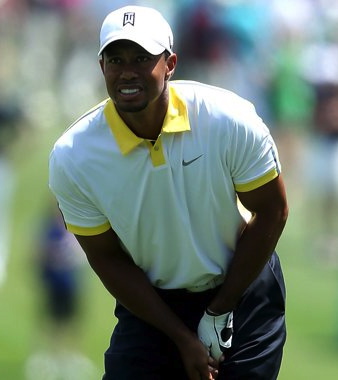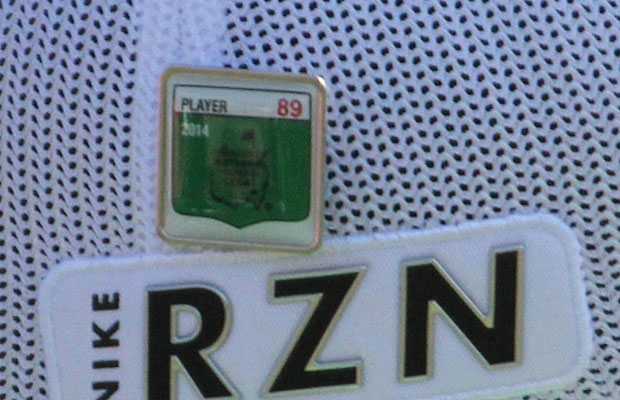Opinion & Analysis
Two ways Tiger could have won and what we learned

“If I shot 65, I thought I could win it,” Tiger Woods said after his final round of the 2013 Masters.
The world’s No.1-ranked golfer went into the tournament with the kind of confidence, playing level and health that haven’t been seen in him for perhaps 10 years. But on Sunday evening he sat in fourth place, snake bit just like so many times in recent years.
Woods has crossed Hogan Bridge many times in public view, but after his latest in a series of near misses I’m starting to wonder if he may have walked under Greg Norman’s Ladder at some point.
For Woods, the operative word for the 2013 Masters is “if.” He was correct that if he has shot 65 he would have won. But the weekend had a couple of other “ifs” to ponder.
If Tiger crushes the par-5s he wins.
The holes at Augusta National Golf Course have names like Azalea, Rosebud and Carolina Cherry — names that reflect serenity and rare beauty. The par-5 No. 8 is named Yellow Jasmine, the par-5 No. 15 is called Firethorn. Woods might think that they would be better described as Black Cat and Broken Mirror.
He has built a career on devouring par-5s and nowhere is this more true than at Augusta. In his four victories, Woods has never been worse than 6-under under par on the par 5s, including the mind-numbing 13-under on the par 5s in 1997.
But Friday at No. 15, Woods made one of the most famous “8’s” in golf history. On Saturday on No. 8, his short par putt took almost two complete tours around the hole before the ball decided that gravity could kiss its butt. Tiger was just 4-under this year on the par-5s; if had executed better on Augusta’s most generous holes he would likely have achieved his goal.
If Tiger doesn’t hit the pin in 15, the golf world stays on its axis.
When the golf world went to bed on Friday night, it was filled with images of the No. 1 player in the world amongst the leaders, poised to make a weekend charge for his fifth green jacket and first since 2005. It awoke to the news that there was a storm brewing in Augusta, Ga., that had nothing to do with the weather.
The bombshell news that Woods might be disqualified for an improper drop on No. 15 during the second round ignited a global conversation that had people from every corner of the world weighing in. From Peter Jacobson to Piers Morgan, everyone had an opinion about what had exactly had happened and what exactly should be the consequences.
The potential outcomes for Tiger were all bad from the moment that ball hit the pin on No. 15 approach. According to Rule 16-1,Woods’ options were to either use the designated drop area, drop from as close as possible to the place where he hit the first shot or drop along the line where the ball last entered the hazard, keeping the hole on that line. Woods chose a kind of hybrid, dropping a few yards back along the line of where the ball first entered the hazard. He hit a shot pin high to within 4 feet of the hole, earning praise not only for executing the shot but also for maintaining his composure.
Tiger spoke to reporters after his round without knowing that potential ramifications. He stated openly and honestly that after considering and rejecting the option to hit from the designated drop area, he had moved back a couple of yards from where he had hit his third shot to give himself a margin of error. After hearing that, rules officials determined that Woods might not have dropped the ball as close as possible. It was only at that point that officials thought it would be a good idea to talk to Woods, who said the same thing that he had said to the media. That led officials to decide to give him a two-stroke penalty and not to DQ him.
Questions Asked
The issues are complex but also quite clear. How did the infraction go undetected by on-course officials? Did Tiger Woods receive preferential treatment? And most importantly, how can a travesty like this be prevented?
Let’s start with the officials.
I spoke to people at the highest levels of the golf industry who were incredulous that there was not some level of intervention from the officials on the course at the time of the incident. They assured me that there is a battalion of rules officials from a variety of golf’s ruling bodies on the course at any given time; what’s more, because of it’s significance and the water present, there were likely at least two rules officials within shouting distance at the time of Woods’ infraction.
Surely one of those pairs of eyes should have recognized that Tiger was about to follow a shot into cold water with a jump into hot water. In every other sport, players are expected to play and officials are expected to officiate. I know that players are expected to know and play by the rules. But there is integrity, and then there is doing your job. During last year’s officials strike the NFL found out the cost of having amateur officials determining the outcome of professional sporting contests.
With millions of eyes watching and millions of dollars on the line, golf needs to get its officiating house in order; to leave any key call up to the knowledge of the players is unfair and inappropriate at this level of competition. Players will still call penalties on themselves, but they shouldn’t have to. Woods was within the rules as he understood them. To suggest something else was afoot seems petty and pointless. When questioned by officials, he was honest and he took his penalty like a man.
Next is the issue of preferential treatment.
The controversy was started by a call to officials by a television viewer; Rule 33-7 was introduced as a way to deal with the fact that television viewers have a say in what goes on in a professional event. The rule is meant to give officials the opportunity to address an issue that has already been addressed without giving a player the death penalty (a DQ) after the fact.
The rule states that a “save” can be made at the discretion of the rules committee, and it is the word discretion that causes the opportunity for conflict.
Saturday’s ruling is by far the most significant use of the rule to save a player from disqualification, and the general question amongst current and former players is whether or not the rules committee would have acted in their favor in similar circumstance. Judging from what is in the Twitterverse, the answer seems to be that they feel they would not have received the same tender mercies that Woods received. But that is conjecture; the fact is that any and all players can and should benefit from rule 33-7; the fact that the most famous player in the world is among the first should ensure that in the future all players would be given the same consideration because of the notoriety that this ruling received.
Some have suggested that Woods should have been disqualified or should have withdrawn from competition for signing a wrong scorecard. But rules officials knew about the controversy before he signed his scorecard. To me it is inexplicable that they did not consult Woods about the issue before he signed his scorecard. Had they done so, they could have assessed the penalty and Woods would have signed an infuriating but incorrect scorecard and we would have had a different conversation.
Lessons Learned
No matter how you feel about what happened on Friday and Saturday, there should be agreement on the point that it’s time to stop managing this problem and start solving it. Golf needs to have a scoring system in place to review questionable calls. How about having a review official in the TV booth the same way that the NFL has one? On-course officials can flag calls for a review that would be completed before the player’s round is completed and an incorrect scorecard is signed.
The problem here is that only the players that are good enough or are doing well enough to merit television coverage would be subject to this review, but these are the only cases where viewer call-ins are an issue. Speaking of viewer call-in, let’s once and for all end the practice of taking outside calls that affect a sporting event. He thought of a viewer call affecting the outcome in any other professional sport is so absurd as to draw laughter. In other sports, players and officials both have to take credit for their excellence and responsibility for their mistakes. Golf should not be the exception.
Lastly, why not have an official score that is kept by the officials? An official digital scorecard can be kept for every foursome, which would mean that the chance of signing for a wrong scorecard would be thing of the past. There are many wonderful traditions in golf; having a player who has left his or her heart on soul on the course only to have that effort wiped away because of bad arithmetic is not one of them. When it happens it not only breaks the heart of existing fans, it drives away potential new fans who rightly find the practice brutal and senseless. The time has come to let players play and let scorers score.
Usually, I am in favor of anything that brings global attention to golf, and the Masters is an event that does it every year because of its beauty and its tradition. It’s unfortunate that when the game should have been taking a star turn, it became mired in a controversy that confused and agitated the lovers of the game and confounded casual fans who wondered how so many smart people could get themselves so fouled up.
What we do know is that this episode opened up a new chapter in the game. Golfers will likely now want to know the rules better, which will help speed up everyday play. And hopefully golf will use this as a wake-up call to take a look at modernizing the scoring and rules process, which is much more crucial to the growth to the growth of the game than how long a putter is.
Opinion & Analysis
The 2 primary challenges golf equipment companies face

As the editor-in-chief of this website and an observer of the GolfWRX forums and other online golf equipment discourse for over a decade, I’m pretty well attuned to the grunts and grumbles of a significant portion of the golf equipment purchasing spectrum. And before you accuse me of lording above all in some digital ivory tower, I’d like to offer that I worked at golf courses (public and private) for years prior to picking up my pen, so I’m well-versed in the non-degenerate golf equipment consumers out there. I touched (green)grass (retail)!
Complaints about the ills of and related to the OEMs usually follow some version of: Product cycles are too short for real innovation, tour equipment isn’t the same as retail (which is largely not true, by the way), too much is invested in marketing and not enough in R&D, top staffer X hasn’t even put the new driver in play, so it’s obviously not superior to the previous generation, prices are too high, and on and on.
Without digging into the merits of any of these claims, which I believe are mostly red herrings, I’d like to bring into view of our rangefinder what I believe to be the two primary difficulties golf equipment companies face.
One: As Terry Koehler, back when he was the CEO of Ben Hogan, told me at the time of the Ft Worth irons launch, if you can’t regularly hit the golf ball in a coin-sized area in the middle of the face, there’s not a ton that iron technology can do for you. Now, this is less true now with respect to irons than when he said it, and is less and less true by degrees as the clubs get larger (utilities, fairways, hybrids, drivers), but there remains a great deal of golf equipment truth in that statement. Think about it — which is to say, in TL;DR fashion, get lessons from a qualified instructor who will teach you about the fundamentals of repeatable impact and how the golf swing works, not just offer band-aid fixes. If you can’t repeatably deliver the golf club to the golf ball in something resembling the manner it was designed for, how can you expect to be getting the most out of the club — put another way, the maximum value from your investment?
Similarly, game improvement equipment can only improve your game if you game it. In other words, get fit for the clubs you ought to be playing rather than filling the bag with the ones you wish you could hit or used to be able to hit. Of course, don’t do this if you don’t care about performance and just want to hit a forged blade while playing off an 18 handicap. That’s absolutely fine. There were plenty of members in clubs back in the day playing Hogan Apex or Mizuno MP-32 irons who had no business doing so from a ballstriking standpoint, but they enjoyed their look, feel, and complementary qualities to their Gatsby hats and cashmere sweaters. Do what brings you a measure of joy in this maddening game.
Now, the second issue. This is not a plea for non-conforming equipment; rather, it is a statement of fact. USGA/R&A limits on every facet of golf equipment are detrimental to golf equipment manufacturers. Sure, you know this, but do you think about it as it applies to almost every element of equipment? A 500cc driver would be inherently more forgiving than a 460cc, as one with a COR measurement in excess of 0.83. 50-inch shafts. Box grooves. And on and on.
Would fewer regulations be objectively bad for the game? Would this erode its soul? Fortunately, that’s beside the point of this exercise, which is merely to point out the facts. The fact, in this case, is that equipment restrictions and regulations are the slaughterbench of an abundance of innovation in the golf equipment space. Is this for the best? Well, now I’ve asked the question twice and might as well give a partial response, I guess my answer to that would be, “It depends on what type of golf you’re playing and who you’re playing it with.”
For my part, I don’t mind embarrassing myself with vintage blades and persimmons chasing after the quasi-spiritual elevation of a well-struck shot, but that’s just me. Plenty of folks don’t give a damn if their grooves are conforming. Plenty of folks think the folks in Liberty Corner ought to add a prison to the museum for such offences. And those are just a few of the considerations for the amateur game — which doesn’t get inside the gallery ropes of the pro game…
Different strokes in the game of golf, in my humble opinion.
Anyway, I believe equipment company engineers are genuinely trying to build better equipment year over year. The marketing departments are trying to find ways to make this equipment appeal to the broadest segment of the golf market possible. All of this against (1) the backdrop of — at least for now — firm product cycles. And golfers who, with their ~15 average handicap (men), for the most part, are not striping the golf ball like Tiger in his prime and seem to have less and less time year over year to practice and improve. (2) Regulations that massively restrict what they’re able to do…
That’s the landscape as I see it and the real headwinds for golf equipment companies. No doubt, there’s more I haven’t considered, but I think the previous is a better — and better faith — point of departure when formulating any serious commentary on the golf equipment world than some of the more cynical and conspiratorial takes I hear.
Agree? Disagree? Think I’m worthy of an Adam Hadwin-esque security guard tackle? Let me know in the comments.
@golfoncbs The infamous Adam Hadwin tackle ? #golf #fyp #canada #pgatour #adamhadwin ? Ghibli-style nostalgic waltz – MaSssuguMusic
Podcasts
Fore Love of Golf: Introducing a new club concept

Episode #16 brings us Cliff McKinney. Cliff is the founder of Old Charlie Golf Club, a new club, and concept, to be built in the Florida panhandle. The model is quite interesting and aims to make great, private golf more affordable. We hope you enjoy the show!
Opinion & Analysis
On Scottie Scheffler wondering ‘What’s the point of winning?’

Last week, I came across a reel from BBC Sport on Instagram featuring Scottie Scheffler speaking to the media ahead of The Open at Royal Portrush. In it, he shared that he often wonders what the point is of wanting to win tournaments so badly — especially when he knows, deep down, that it doesn’t lead to a truly fulfilling life.
View this post on Instagram
“Is it great to be able to win tournaments and to accomplish the things I have in the game of golf? Yeah, it brings tears to my eyes just to think about it because I’ve literally worked my entire life to be good at this sport,” Scheffler said. “To have that kind of sense of accomplishment, I think, is a pretty cool feeling. To get to live out your dreams is very special, but at the end of the day, I’m not out here to inspire the next generation of golfers. I’m not out here to inspire someone to be the best player in the world, because what’s the point?”
Ironically — or perhaps perfectly — he went on to win the claret jug.
That question — what’s the point of winning? — cuts straight to the heart of the human journey.
As someone who’s spent over two decades in the trenches of professional golf, and in deep study of the mental, emotional, and spiritual dimensions of the game, I see Scottie’s inner conflict as a sign of soul evolution in motion.
I came to golf late. I wasn’t a junior standout or college All-American. At 27, I left a steady corporate job to see if I could be on the PGA Tour starting as a 14-handicap, average-length hitter. Over the years, my journey has been defined less by trophies and more by the relentless effort to navigate the deeply inequitable and gated system of professional golf — an effort that ultimately turned inward and helped me evolve as both a golfer and a person.
One perspective that helped me make sense of this inner dissonance around competition and our culture’s tendency to overvalue winning is the idea of soul evolution.
The University of Virginia’s Division of Perceptual Studies has done extensive research on reincarnation, and Netflix’s Surviving Death (Episode 6) explores the topic, too. Whether you take it literally or metaphorically, the idea that we’re on a long arc of growth — from beginner to sage elder — offers a profound perspective.
If you accept the premise literally, then terms like “young soul” and “old soul” start to hold meaning. However, even if we set the word “soul” aside, it’s easy to see that different levels of life experience produce different worldviews.
Newer souls — or people in earlier stages of their development — may be curious and kind but still lack discernment or depth. There is a naivety, and they don’t yet question as deeply, tending to see things in black and white, partly because certainty feels safer than confronting the unknown.
As we gain more experience, we begin to experiment. We test limits. We chase extreme external goals — sometimes at the expense of health, relationships, or inner peace — still operating from hunger, ambition, and the fragility of the ego.
It’s a necessary stage, but often a turbulent and unfulfilling one.
David Duval fell off the map after reaching World No. 1. Bubba Watson had his own “Is this it?” moment with his caddie, Ted Scott, after winning the Masters.
In Aaron Rodgers: Enigma, reflecting on his 2011 Super Bowl win, Rodgers said:
“Now I’ve accomplished the only thing that I really, really wanted to do in my life. Now what? I was like, ‘Did I aim at the wrong thing? Did I spend too much time thinking about stuff that ultimately doesn’t give you true happiness?’”
Jim Carrey once said, “I think everybody should get rich and famous and do everything they ever dreamed of so they can see that it’s not the answer.”
Eventually, though, something shifts.
We begin to see in shades of gray. Winning, dominating, accumulating—these pursuits lose their shine. The rewards feel more fleeting. Living in a constant state of fight-or-flight makes us feel alive, yes, but not happy and joyful.
Compassion begins to replace ambition. Love, presence, and gratitude become more fulfilling than status, profits, or trophies. We crave balance over burnout. Collaboration over competition. Meaning over metrics.
Interestingly, if we zoom out, we can apply this same model to nations and cultures. Countries, like people, have a collective “soul stage” made up of the individuals within them.
Take the United States, for example. I’d place it as a mid-level soul: highly competitive and deeply driven, but still learning emotional maturity. Still uncomfortable with nuance. Still believing that more is always better. Despite its global wins, the U.S. currently ranks just 23rd in happiness (as of 2025). You might liken it to a gifted teenager—bold, eager, and ambitious, but angsty and still figuring out how to live well and in balance. As much as a parent wants to protect their child, sometimes the child has to make their own mistakes to truly grow.
So when Scottie Scheffler wonders what the point of winning is, I don’t see someone losing strength.
I see someone evolving.
He’s beginning to look beyond the leaderboard. Beyond metrics of success that carry a lower vibration. And yet, in a poetic twist, Scheffler did go on to win The Open. But that only reinforces the point: even at the pinnacle, the question remains. And if more of us in the golf and sports world — and in U.S. culture at large — started asking similar questions, we might discover that the more meaningful trophy isn’t about accumulating or beating others at all costs.
It’s about awakening and evolving to something more than winning could ever promise.




















tnuts
Apr 17, 2013 at 9:25 am
The only question I have is what about the other players in the field? How do you call in a rules infraction on them? Viewer call ins on the rules is quite ridiculous considering the amount of money and stress involved with playing in such high profile event.
Kevin S, PGA
Apr 16, 2013 at 10:51 pm
I couldn’t disagree more..I think signing a correct scorecard and being responsible for it are as much of a tradition of the game as anything else. I also think that part of what makes golf such a. Great game is players calling penalties on themselves and the honor system. Take that away and a lot of tradition goes with it. I do agree however with eliminating the practice of fans calling in with rules disputes.
Kevin S, PGA Professional, Park Ridge, NJ
Joe C
Apr 16, 2013 at 9:45 am
If a person is going to play golf in competition for tons of money and notariety I think they should know the rules of the game better than anyone. If a player does not know them and get caught breaking one it is not the fault of any referee, official, or committee, or TV viewer, it is the player’s fault. Anybody who believes otherwise does not understand how golf is meant to be played at its highest level.
I believe Tiger unintentionally broke the rule but still should have applied the proper penalty to himself once he was aware of the infraction. And the penalty for signing an incorrect card is disqualification, not two strokes.
Having an official scorekeeper would be OK as long as a player still had to sign his name to his card.
Chris
Apr 16, 2013 at 9:21 am
It was a tough break but it is what it is. He got unlucky but to say it cost him the tournament is debateable. He had several other chances to make up strokes and didn’t take advantage. He would be the first person to tell you that. Eyes set on the US Open now.
Ty
Apr 16, 2013 at 8:12 am
Good point Tommy – I can’t think of a better situational shot than Cabrera’s off the top of my head. That man certainly has some cajones. What amazes me is that Tiger’s B game is almost capable of winning majors. If his ball had never hit the flagstick on 15, he would have ended up 4 shots better and in a 3-way playoff at 9 under par.
Steve
Apr 16, 2013 at 1:28 pm
I would go as far to say he probably would have ended up 5 strokes better. That was one of those shots that looked like it would have stopped right next to the pin for an easy birdie putt.
TWShoot67
Apr 16, 2013 at 5:10 pm
IF, IF , IF. we all know the old saying if my aunt had …. she’s be my uncle. The fact is we’ll never know how this all would have went down if things were handled correctly by officials. It has to mess with your mindset when you go to bed with one score then wake up to find your being penalized 2 shots. Not saying tiger didn’t deserve the 2 shot penalty. Just saying what IF…… LOL
Part 2 IF Tiger never hit the flag he may have gone on a little run and went into Saturday with a lead and we all know what happens most times when Tiger’s in that position. IF IF IF. Tiger will be fine. Now the rules committee needs to stop the outside agency (phone callers) NOW! Arnold, Jack, and Ben never dealt with that at all during their round in the middle of a MAJOR CHAMPIONSHIP!
Tommy
Apr 16, 2013 at 12:30 am
The 2 shot penalty did not prevent him from winning. He would still have missed the playoff by 2 shots. If he had made a “weekend charge” maybe he would have been closer. There was no weekend charge. Even without the 2 shot penalty on Friday’s score he didn’t break 70 on any day. He simply didn’t play well enough to win.
On a more positive note, has there ever been a better situational shot than Cabrera’s 7 iron on 18, knowing he had to birdy to tie.
Ty
Apr 15, 2013 at 11:42 pm
Also, “unknowingly” breaking the rule would qualify as an inadvertent mistake you moron.
Ty
Apr 15, 2013 at 11:41 pm
Jay – 33-7 was used in this instance to save Tiger from the committee’s mistake. Standard procedure on a call-in penalty like that is to review the potential infraction with the player in question before he signs his scorecard in the scorer’s tent. In this case, they reviewed the potential infraction on there own and deemed that there had been no infraction. If they had simply followed protocol and confronted Tiger, he would have added the 2 strokes before he signed and there would be no discussion whatsoever.
Steve
Apr 16, 2013 at 1:25 pm
This
Jay
Apr 15, 2013 at 11:00 pm
I thought the purpose of 33-7 was to save a golfer from an inadvertent mistake. Knowingly or not, Tiger broke the rule to gain an advantage. He wanted 4 yards off the shot, so he moved back 2 yards and took 2 yard off with the swing.
Dalton
Apr 15, 2013 at 5:16 pm
A lot of people are up in arms about the call in rulings. The Dustin Johnson ruling was a call in too, and I don’t remember there being a big fuss then. Maybe I just don’t remember it, but for everyone crying about tiger getting preferential treatment this would definitely be a case. When a rule negatively effects him there is a storm of outcry to change the rule.
Steve
Apr 16, 2013 at 1:24 pm
There were a ton of people that:
A) thought calling in was ridiculous
B) thought it was a dumb call to even claim that was a bunker
If the rule was in place back then, I’d be willing to bet DJ would have been “saved” as well.
Jeff
Apr 15, 2013 at 4:36 pm
wait, you say he was “only” -4 on the par 5s for the week? Even forgetting the craziest-triple-bogey-of-all-time, playing 16 holes at -4 is pretty darn good for anyone, including tour pros. His entire score was -5…I’m thinking if he had played THE REST OF THE HOLES as well as he played the par 5s he would’ve won.
Mike B.
Apr 15, 2013 at 3:59 pm
I believe Tiger will win 2 majors this year, so don’t feel too sorry for him. Now if he could only hit his driver into the fairway, he’d be untouchable!
Ty
Apr 15, 2013 at 3:25 pm
Carmine Conti, what you’ve just said … is one of the most insanely idiotic things I have ever heard. At no point in your rambling, incoherent response were you even close to anything that could be considered a rational thought. Everyone in this room is now dumber for having listened to it. I award you no points, and may God have mercy on your soul.
This one falls on the Rules Committee. After the caller notified them of the potential infraction, they should have not only reviewed the tape themselves but also notified Tiger in the scorer’s tent before he signed his card. Had they done this, Tiger would have admitted his mistake, signed for the correct score and all of this would be a non-issue.
Steve
Apr 16, 2013 at 1:21 pm
Lol +1 for the Billy Madison reference.
Barry Smoot
Apr 15, 2013 at 3:05 pm
The “Viewer Phone Caller” was Jack
Servost
Apr 15, 2013 at 10:05 pm
Thats a good one
Carmine Conti
Apr 15, 2013 at 2:45 pm
Once Again were all left scratching our Nike Hatted Heads wondering why and how come…. The Key Point or decision was made prior to his round ending,,,after the viewer phone call, the Rules Committee of Augusta National made the decision that his drop was legal…. Lets Stop right there…… How do they decide or in God’s name do they see that as a “legal drop”…. Now the debate begins….. I give Mr Woods credit for admitting what his intent was, as well as what his intent was with twelve woman he dialed in, but for the acclaimed and holier than thou Augusta Committee of the “sacred” to not penalize immediately is unacceptable… Refs on the course absolutely, and if they miss the call, there is no foul,unless like in the movie “Bagger Vance” the player calls it on himself… For the “Greatest Golfer of All Time” what an example he would of set,, but On-Course Officials, could prevent, (as in other Sports) cheating, and the calls from viewers will cease and desist…. This though was not good for the game, and Mr. Woods knowing his intent, should’ve “Withdrew”, showing even he is not bigger than the game, when intel, it would of showed all the world he’s respectful of the what has made him the icon he so desperately wants to be… In this case even if he’d had won….”It Woods not of taken care of everything”….
Mario
Apr 15, 2013 at 10:38 pm
THUMBS UP
chris
Apr 15, 2013 at 2:38 pm
He screwed up, he lost, it is done. Get on with life.
Raul Schwarx
Apr 15, 2013 at 2:20 pm
Finally someone makes the proper analysis… Congratulations on a well researched and developed article. Broadcasters should learn from this !
bob
Apr 15, 2013 at 2:20 pm
Sorry for the typos
bob
Apr 15, 2013 at 2:19 pm
Enough with the tiger this or that he lost but so did a wholr bunch of other good golfers and men. On another note keeping your own score is more inherent to the integrity of the game then long ,shooort or another club length. You need to refocus .
TWShoot67
Apr 15, 2013 at 2:13 pm
Yes there needs to be some changes for sure. In no way should a spectator at home or on course having any influence on the game. second half of the field cold be making same mistake Tiger made and it would go undetected to TV viewer as said players is ever on TV like the leaders of an event are. The game needs to be fair for everyone and like any other sports mistakes happen even with refs. But guess what we live with them. In baseball strike zones are subject to ridicule ever single game. In basketball and football fouls get called and some do not. Golf needs to have referees in place and they make the call and that’s it. No more second guessing TV viewer calling in and then changing what happens. All I know NO ONE that watched on Friday that I sat with thought anything Tiger did was wrong. In fact if you listed to David Feherty who’s sitting in a booth and a former player was under no pressure and he didn’t even know which hazard it was yellow or Red! Things definitely need to change and it’s up to golf to not let anything like this happen again. Also if TV/Media thought tiger was evasive in the past after post round interviews, I could see him being even more vague as his statements along with a phone caller and a late night dinner changed the course of the Masters. One last though thanks for a well written article! Tim
Allen
Apr 16, 2013 at 6:16 am
I’ve been thinking about this supposed “TV viewer” calling in rules infractions and feel certain that I’m not the first one to think: how in the world do they know what number to call; who to speak with: why do they take their call. if I called the Augusta National today would Billy Payne take my call? Common sense tells me that if isn’t an ordinary viewer. I suspect it is either a disgruntled marginal pro or a member of the golf media. My hunch is it is the latter. Most pros wouldn’t know who to call either and since there has never been one single story pursuing the identity of these “callers”, it sure looks like a conspiracy of silence.
Steve
Apr 16, 2013 at 1:17 pm
I was thinking the exact same thing lol.